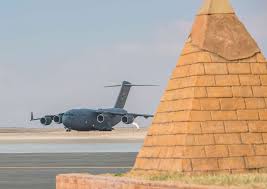
C-17 Lands at Wrong Airport: What Happened
C-17 Globemaster Landing at the Wrong Airport: Understanding the Incident
The C-17 Globemaster is a military transport aircraft with a reputation for reliability. However, there have been cases where this giant has landed at the wrong airport. Such incidents highlight the complex nature of aviation operations and the importance of precision in navigation.
The Aircraft
The Boeing C-17 Globemaster III is one of the most versatile military transport aircraft. It was developed for the United States Air Force and first flew in 1991. The C-17 can transport troops, vehicles, and equipment anywhere it’s needed. It’s built to land on short and unprepared airstrips, which is why it’s used for tactical and strategic airlift missions. With a range of over 2,400 nautical miles and a maximum payload of around 77 tonnes, it’s a reliable workhorse of many air forces.
Navigation Technology
The C-17 is equipped with advanced navigation systems. These systems include GPS, inertial navigation, and other avionics meant to enhance accuracy. Pilots rely on these tools to ensure they reach the intended destination. Despite high-tech navigation aids, human error and other factors can sometimes lead to mistakes. Such errors can result in landing at the wrong airport, showcasing potential gaps in protocol or execution.
Past Incidents
One notable incident occurred in 2012 when a C-17 mistakenly landed at Peter O. Knight Airport, Florida. This small airport wasn’t equipped to handle such a large aircraft. The intended destination was MacDill Air Force Base situated nearby. The error became apparent upon landing. Surprisingly, the short runway, measuring about 3,580 feet, posed no significant challenge for the C-17, which is designed for such conditions. Pilots managed to take off without incident after determining the aircraft’s capabilities matched the requirements.
Another incident involved a C-17 landing at an airstrip in Afghanistan in 2019. It highlights the challenges faced in a military environment, where multiple factors can complicate operations. In these cases, pilots must often make quick decisions based on rapidly changing information. The similar layout of airfields and confusing surroundings added further complexity to navigation.
Reasons for Errors
Several factors contribute to wrong airport landings. These include human error, miscommunication, and technical issues. Human error often occurs due to misinterpretation of data or a lapse in critical decision-making. Stress and fatigue also play roles, especially in high-demand missions. Miscommunication between crew members or with air traffic control can result in misunderstandings. Such issues may stem from unclear instructions or radio frequency mix-ups. Technical malfunctions, though rare, can disrupt navigation systems, leading to faulty coordinates.
Technological Evolution
Advancements in aviation technology continue to reduce the likelihood of such errors. Automation and Machine Learning are being integrated into navigation systems. These technologies offer real-time analysis and correction of potential errors. Enhanced GPS and satellite navigation improve precision, while new communications technologies reduce miscommunication risks. Nevertheless, technology isn’t infallible. Combining human oversight with technology ensures added security against errors.
Procedural Adjustments
The aviation industry has adjusted procedures to counteract wrong airport landings. Emphasis on thorough training ensures crews can handle unexpected situations. Simulation training provides pilots with experience in handling navigation errors. Protocols for double-checking coordinates before landing introduce another safeguard. Regular audits and updates to Air Traffic Control procedures ensure clarity and efficiency in communication.
Learning from Past Mistakes
Examining past incidents helps in understanding the intricacies involved in avoiding wrong airport landings. These evaluations produce enhanced safety protocols and training methods. They also reiterate the importance of situational awareness and vigilance among crew members. Continuous learning and adaptation help prevent similar occurrences in the future. Careful analysis offers insights into the optimal combination of human input and technological aid in navigation and decision-making.
Conclusion
While the C-17 Globemaster III remains a remarkable aircraft, these incidents serve as reminders that navigation in aviation isn’t straightforward. Learning from such episodes strengthens the aviation community’s resolve to refine and improve systems continually. The focus on improving both technology and human factors ensures that the lessons from past mistakes foster future resilience and reliability in aviation operations.